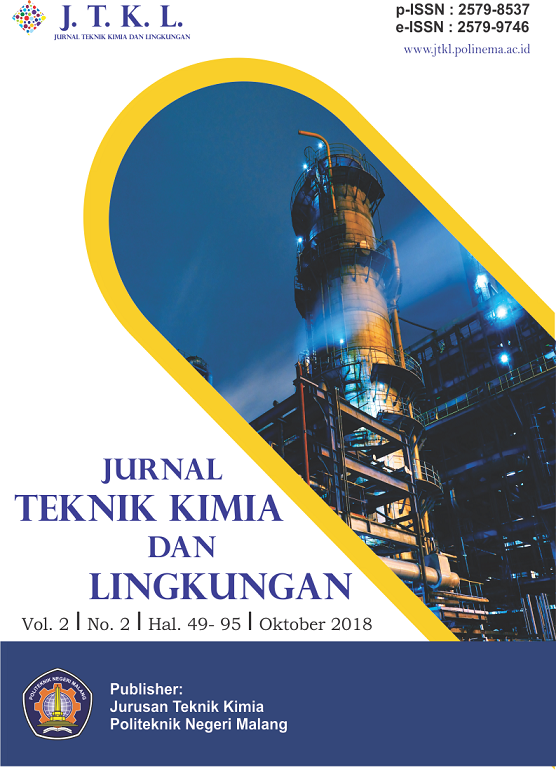Pengaruh Kedalaman Anoda pada Metode Contact Glow Discharge Electrolysis (CGDE) dalam Degradasi Pewarna Tekstil Remazol Red
DOI:
https://doi.org/10.33795/jtkl.v2i2.74Keywords:
CGDE, degradation of textile dye waste, hydroxyl radicals, plasmaAbstract
Limbah pewarna tekstil yang mempunyai komponen utamanya zat pewarna sintesis berbahaya bagi lingkungan sekitar. Pengolahan limbah pewarna tekstil secara fisika dan biologi kurang efektif. Elektrolisis plasma dengan menggunakan metode Contact Glow Discharge Electrolysis (CGDE) merupakan bagian dari pengolahan secara kimiawi, yang efektif dalam mengolah limbah pewarna batik. Parameter kedalaman anoda sangat mempengaruhi dalam proses elektrolisis plasma metode CGDE. Tujuan penelitian ini adalah untuk mengetahui pengaruh kedalaman anoda terhadap produksi •OH, energi yang digunakan proses degradasi, persen dekolorisasi Remazol Red RB 133, serta mengetahui penurunan konsentrasi COD limbah pewarna batik Remazol Red RB 133. Kedalaman anoda dalam penelitian ini adalah 1,5 cm dimana produksi •OH sebesar 11,63 mmol dan energi proses selama 30 menit adalah 806,4 KJ. Persen dekolorisasi Remazol Red RB 133 pada konsentrasi 250 ppm, terbesar selama 30 menit mencapai 99,66 %, pada kedalaman 4,5 cm dengan energi 1075,212 KJ. Nilai COD limbah pewarna batik Remazol Red RB 133 menurun dari 169 mg/L menjadi 3,6 mg/L setelah proses CGDE selama 180 menit (sesuai dengan baku mutu limbah).
Textile dye waste having the main component of synthetic dye is hazardous to the surrounding environment. Textile dye waste treatment is physically and biologically less effective. Electrolysis plasma that used Contact Glow Discharge Electrolysis (CGDE) method is part of chemical treatment. The anode depth parameters greatly affect the electrolysis CGDE method. The purpose of this study was to determine the effect of anode depth on • OH production, the energy used in the degradation process, percent decolorization of Remazol Red RB 133, as well as knowing the decrease in COD concentration of Remazol Red batik dye RB 133. The anode depth in this study is 1.5 cm where the production of OH • 11.63 mmol and the processing energy for 30 minutes is 806.4 KJ. The largest Percentage degradation of Remazol Red RB 133 at concentration 250 ppm is 99,66%, that’s reach at depth 4.5 cm for 30 minutes with energy 1075,212 KJ. COD value has decreased from 169 mg/L to 3,6 mg/L after 180 minutes CGDE process (conform to waste quality standards).
References
J. Gao, X.Wang, Z. Hu, H. Deng, J. Hou, X. Lu, J. Kang, Plasma Degradation Of Dyes In Water with Contact Glow Discharge Electrolysis, Water Research, vol. 37, hal. 267-272, 2003.
M. Marcuci, G. Ciardelli, A. Matteucci, L. Ranieri, M. Russo, Experimental Campaigns On Textile Wastewater For Reuse by Means of Different Membrane Processes, Desalination, vol. 149, hal. 137-143, 2002.
X. Wang, M. Zhou, X. Jin, Application of Glow Discharge Plasma For Wastewater Treatment, Electrochimica Acta, vol. 83, hal. 501- 512, 2012.
N. Saksosno, I. Nugraha, M. Gozan, S. Bismo, Plasma Formation Energi And Hydroxyl Production On Contact Glow Discharge Electrolysis, International Journal of Arts & Sciences, vol. 07(03), hal. 71–77, 2014.
B. Jiang, J. Zheng, S. Qiu, M. Wu, Q. Zhang, Z. Yan, Q. Xue, Review On Electrical Discharge Plasma Technology For Wastewater Remediation, Chemical Engineering Journal, vol. 236, hal. 348-368, 2014.
N. Saksono, B. P. Adiwidodo, E. F. Karamah, S. Kartohardjono, Contact Glow Discharge Electrolysis System for Treatment of Wastewater Containing Ammonia, Journal of Environmental Science and Technology, vol. 6(1), hal. 41-49, 2013.
S. Bismo, K. Irawan, E. F. Karamah, N. Saksono, On The Production Of OH Radical Through Plasma Electrolysis Mechanism For The Processing Of Ammonia Waste Water,
J. Chem. Chem. Eng, vol. 7, hal. 6-12. 2013.
J. Gao, J. Yu, Q. Lu, X. He, W. Yang, Y. Li, L. Pu, Z. Yang, Decoloration of alizarin red S in aqueous solution by glow discharge electrolysis, Dyes and Pigments, vol. 76, hal. 47-52. 2008.
Y. Liu, D. Wang, B. Sun, X. Zhu, Aqueous 4-nitrophenol Decomposition and Hydrogen Peroxide Formation Induced by Contact Glow Discharge Electrolysis, Journal of Hazardous Materials, vol. 181, hal. 1010-1015, 2010.
X. Jin, X. Wang, J. Yue, Y. Cai, H. Zhang, The Effect of Electrolysis Constituents on Contact Glow Discharge Electrolysis, Electrochimica Acta, vol. 56, hal. 925- 928, 2010.
J. Gao, J. Yu, Y. Li, X. He, L. Bo, L. Pu, W. Yang, Q. Lu, Z. Yang, Decoloration Of Aqueous Brilliant Green By Using Glow Discharge Electrolysis. Journal of hazardous materials, vol. 137, hal. 431-436, 2006.
L. Wang, X. Jiang, Y. Liu, Degradation Of Bisphenol A And Formation Of Hydrogen Peroxide Induced By Glow Discharge Plasma In Aqueous Solutions. Journal of Hazardous Materials, vol. 154, hal. 1106–1114, 2008.
Peraturan Menteri Negara Lingkungan Hidup Nomor 05 Tahun 2014.
N. Saksono, I. Puspita, T. Sukreni, Application of Contact Glow Discharge Electrolysis Method for Degradation of Batik Dye Waste Remazol Red by The Addition of Fe2+ Ion, in: AIP Conference Proceedings 1823, 2017.
Q. Lu, J. Yu, J. Gao, W. Yang, Y. Li, Glow‐discharge Electrolysis Plasma Induced Synthesis of Polyvinylpyrrolidone/Acrylic Acid Hydrogel and its Adsorption Properties for Heavy‐metal Ions, Plasma Processes and Polymers, in: 16th International Conference On Plasma Surface Engineering, in Garmisch-Pertenkirchen Germany, vol. 8(9), hal. 803-814, 2011.
Downloads
Published
Issue
Section
License
Copyright (c) 2023 Dian Ratna Suminar, Nelson Saksono

This work is licensed under a Creative Commons Attribution-NonCommercial 4.0 International License.







